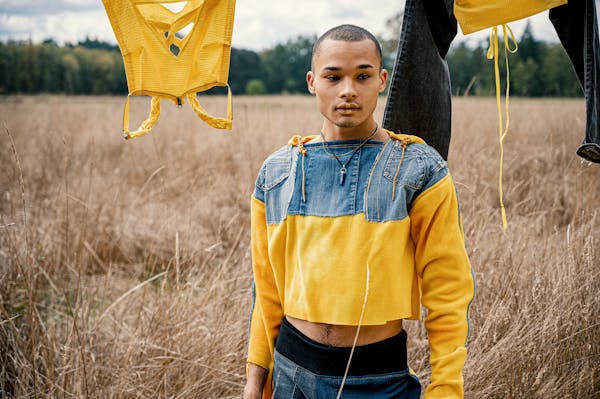Introduction: A Sustainable Shift in Fashion
Fashion has long been associated with luxury, glamour, and fleeting trends, but in recent years, there’s been a transformative shift. As more consumers become aware of the environmental toll the fashion industry has taken on our planet, eco-conscious fashion is taking center stage. The “green revolution” in fashion isn’t just a passing trend—it’s a fundamental change in how brands design, produce, and distribute their clothing. So, what does the future hold? Let’s dive into why the future of fashion is green and explore the top eco-conscious brands leading this sustainable revolution.
Why Green Fashion is the Future
The fashion industry is responsible for a significant portion of global pollution. From the toxic dyes used in garment production to the massive amounts of waste generated by fast fashion, the environmental impact has been nothing short of devastating. Fortunately, there’s a growing demand for change, and the future of fashion is increasingly focused on sustainability.
The Environmental Impact of Fast Fashion
Fast fashion has reshaped the way we think about clothing. With trends changing rapidly, clothing is produced quickly and at a low cost, leading to massive overproduction and waste. But this comes at a high environmental cost. The textile industry is one of the largest polluters globally, emitting more carbon dioxide than international flights and shipping combined. Water consumption, harmful chemical use, and labor exploitation are just a few of the many issues fast fashion presents.
Consumer Demand for Eco-Conscious Products
As consumers become more environmentally aware, they’re starting to demand sustainable options. The rise of conscious consumerism is pushing brands to adopt more ethical and sustainable practices. According to recent reports, consumers are increasingly willing to pay a premium for products that are eco-friendly, signaling a paradigm shift in how we approach fashion.
Ethical Fashion: A Growing Trend
In addition to environmental concerns, ethical fashion is gaining ground. Consumers are no longer just concerned with the planet; they want to know the people behind the products are treated fairly. Ethical fashion focuses on transparency, fair labor practices, and ensuring workers are paid living wages. The rise of certifications like Fair Trade and Global Organic Textile Standard (GOTS) has helped guide brands towards more responsible practices.
Top Eco-Conscious Fashion Brands Leading the Change
Several brands are pioneering the way towards a greener fashion industry. These brands are committed to sustainability, from the materials they use to their ethical labor practices.
Patagonia: A Pioneer in Sustainable Fashion
Patagonia is often hailed as a pioneer in eco-conscious fashion. Known for its outdoor wear, Patagonia has long embraced sustainable practices. The brand uses recycled materials, such as polyester from plastic bottles, and ensures its clothing is durable to reduce waste. Additionally, Patagonia donates a portion of its profits to environmental causes and promotes responsible consumption through initiatives like their “Worn Wear” program, which encourages customers to buy used gear.
Stella McCartney: Luxury with a Conscience
Stella McCartney is the epitome of luxury fashion with a sustainable twist. The brand has been a leader in using alternative materials like organic cotton, recycled polyester, and plant-based leather. Stella McCartney’s commitment to animal rights and sustainability has helped shift the narrative around high-end fashion, proving that luxury can be both ethical and eco-friendly.
Reformation: Eco-Friendly Fashion for All
Reformation has built its entire brand around sustainability. This Los Angeles-based company creates stylish, on-trend clothing using sustainable fabrics like Tencel and organic cotton. Reformation also prioritizes low-waste production and energy-efficient practices. One of the brand’s most impressive features is its transparency—each item on its website includes information about the environmental impact of that piece of clothing, allowing consumers to make informed decisions.
Allbirds: Stylish Shoes with a Low Carbon Footprint
Allbirds revolutionized the footwear industry by creating shoes made from sustainable materials like merino wool, eucalyptus trees, and sugarcane. The brand focuses on minimizing its carbon footprint and uses renewable energy to power its manufacturing. Allbirds also measures the carbon footprint of each pair of shoes and has taken steps to offset it, making it a prime example of how eco-consciousness can be integrated into everyday products.
Everlane: Transparent Fashion Choices
Everlane is known for its radical transparency, a philosophy that sets it apart from many other fashion brands. The company openly shares information about its production processes, labor practices, and the cost breakdown of its products. Everlane uses sustainable materials like organic cotton, and its “ReNew” collection, made from recycled plastic bottles, is a prime example of its commitment to eco-friendly fashion.
Veja: Revolutionizing Sneakers with Sustainability
Veja has become synonymous with eco-conscious sneakers. This French brand uses organic cotton, wild rubber, and recycled materials to create stylish, high-quality shoes. What sets Veja apart is its commitment to fair trade practices, ensuring that farmers and workers involved in the production process are paid fairly. Veja’s sneakers have become a staple for anyone looking to make sustainable fashion choices without sacrificing style.

What Makes a Fashion Brand Eco-Conscious?
When determining whether a brand is truly eco-conscious, several key factors come into play. Here’s what to look for:
Use of Sustainable Materials
Eco-conscious brands prioritize materials that have minimal environmental impact. This includes organic cotton, recycled polyester, hemp, and plant-based alternatives to leather. These materials are not only better for the planet but also often result in products that are of higher quality and longer-lasting.
Ethical Labor Practices and Fair Wages
A truly eco-conscious brand doesn’t just focus on the environment; it also considers the welfare of its workers. Brands committed to sustainability often implement fair trade practices and ensure workers are paid living wages and work in safe conditions.
Recycling and Circular Fashion
Circular fashion is a key aspect of eco-consciousness. This involves designing clothes that can be recycled or upcycled at the end of their life. Brands that prioritize recycling help close the loop in the fashion industry, reducing waste and promoting a more sustainable lifecycle for their products.
How Consumers Can Support Eco-Conscious Fashion
Consumers play a crucial role in shaping the future of fashion. Here’s how you can contribute:
Shopping with Purpose
When you choose to shop from eco-conscious brands, you’re voting with your wallet. Prioritize quality over quantity and choose pieces that will stand the test of time.
Investing in Quality Over Quantity
Instead of purchasing fast fashion pieces that may fall apart after a few wears, invest in high-quality, sustainable items that you can wear for years. This reduces waste and supports brands that prioritize sustainability.
Challenges in the Eco-Conscious Fashion Industry
Despite the growing popularity of sustainable fashion, the industry faces several challenges.
Sourcing Sustainable Materials
One of the biggest hurdles for brands is sourcing sustainable materials that are both high-quality and affordable. As demand for eco-friendly fabrics increases, so does the competition for these materials, making it difficult for smaller brands to compete.
Overcoming Greenwashing in the Fashion Industry
Greenwashing is a significant challenge in the eco-conscious fashion industry. Some brands claim to be sustainable without backing it up with real practices. Consumers must remain vigilant and do their research to ensure the brands they support are genuinely eco-friendly.
Conclusion: Embracing a Green Fashion Future
The future of fashion is undeniably green. As awareness of the fashion industry’s environmental and social impact grows, more brands are embracing sustainability and ethical practices. By supporting eco-conscious brands, consumers are helping to create a greener, more responsible fashion industry that can thrive in the future. The shift toward sustainable fashion is not just a trend; it’s a movement that’s here to stay.
FAQs
- What makes a brand eco-conscious? An eco-conscious brand prioritizes sustainability through the use of sustainable materials, ethical labor practices, and environmentally friendly production methods.
- Are eco-friendly clothes more expensive? While eco-friendly clothes can sometimes cost more upfront, they are often of higher quality and longer-lasting, making them a more sustainable investment in the long run.
3
4o
ChatGPT 说:
. What are some examples of sustainable materials? Sustainable materials include organic cotton, recycled polyester, hemp, Tencel, and plant-based alternatives to leather.
- How can I tell if a brand is truly sustainable? Look for transparency in the brand’s practices, such as clear information about their materials, labor practices, and environmental impact.
- Can I find sustainable fashion at affordable prices? Yes, many sustainable brands offer affordable options, especially when you focus on quality over quantity and invest in pieces that will last for years.
